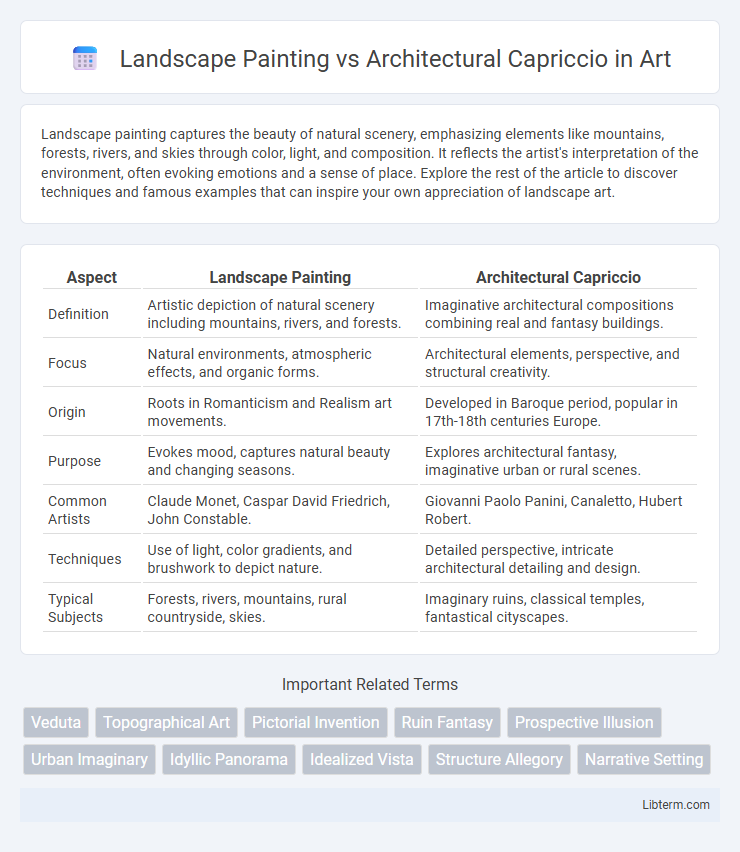Landscape painting captures the beauty of natural scenery, emphasizing elements like mountains, forests, rivers, and skies through color, light, and composition. It reflects the artist's interpretation of the environment, often evoking emotions and a sense of place. Explore the rest of the article to discover techniques and famous examples that can inspire your own appreciation of landscape art.
Table of Comparison
| Aspect | Landscape Painting | Architectural Capriccio |
|---|---|---|
| Definition | Artistic depiction of natural scenery including mountains, rivers, and forests. | Imaginative architectural compositions combining real and fantasy buildings. |
| Focus | Natural environments, atmospheric effects, and organic forms. | Architectural elements, perspective, and structural creativity. |
| Origin | Roots in Romanticism and Realism art movements. | Developed in Baroque period, popular in 17th-18th centuries Europe. |
| Purpose | Evokes mood, captures natural beauty and changing seasons. | Explores architectural fantasy, imaginative urban or rural scenes. |
| Common Artists | Claude Monet, Caspar David Friedrich, John Constable. | Giovanni Paolo Panini, Canaletto, Hubert Robert. |
| Techniques | Use of light, color gradients, and brushwork to depict nature. | Detailed perspective, intricate architectural detailing and design. |
| Typical Subjects | Forests, rivers, mountains, rural countryside, skies. | Imaginary ruins, classical temples, fantastical cityscapes. |
Defining Landscape Painting: Nature Captured on Canvas
Landscape painting captures natural scenery such as mountains, forests, rivers, and skies, emphasizing the artist's interpretation of light, color, and atmosphere. It aims to depict the realistic or idealized beauty of nature, often conveying moods through detailed brushwork and perspective. Unlike architectural capriccio, which combines imaginative and classical architectural elements, landscape painting remains focused on the natural environment and its organic forms.
What is Architectural Capriccio? An Artistic Fantasy
Architectural capriccio is an artistic fantasy that combines real and imaginary architectural elements into a single, imaginative composition, often blending ruins, classical structures, and fantastical buildings. Unlike traditional landscape painting, which depicts natural scenery with realistic perspectives, architectural capriccio emphasizes creative invention, playing with scale, perspective, and architectural styles to create a dreamlike environment. This genre highlights the artist's skill in architectural detail while exploring the interplay between reality and imagination.
Historical Origins: Tracing Both Art Forms
Landscape painting originated during the Renaissance as artists began to emphasize natural scenery and outdoor settings, reflecting a growing appreciation for nature's aesthetic and symbolic qualities. Architectural capriccio emerged in the 17th century, particularly in Italy, combining imaginary architectural elements with real structures to create fantastical cityscapes that showcased the artist's creativity and technical skills. Both art forms evolved from a fascination with space and perspective, but while landscape painting focused on natural environments, architectural capriccio centered on imaginative urban and architectural fantasies.
Key Themes in Landscape Painting
Landscape painting emphasizes the realistic depiction of natural scenery, exploring themes such as light, atmosphere, and seasonal changes to evoke mood and place. It often captures the harmonious relationship between humans and nature, reflecting pastoral tranquility, wilderness, or human impact on the environment. This contrasts with architectural capriccio, which prioritizes imaginative and fantastical architectural elements over natural landscapes, focusing on architectural innovation and romantic ruins.
The Imaginative World of Architectural Capriccio
Architectural Capriccio transforms traditional landscape painting by incorporating fantastical and imaginative architectural elements that defy real-world constraints. This genre blends ruins, classical buildings, and creative structures into surreal compositions, enhancing visual storytelling with mystery and whimsy. The imaginative world of Architectural Capriccio invites viewers to explore impossible spaces that challenge perceptions of reality through expertly detailed and atmospheric scenes.
Technique Comparison: Brushwork, Color, and Composition
Landscape painting employs varied brushwork to capture natural textures and atmospheric depth, using a broad palette that reflects realistic or impressionistic light and color. Architectural capriccio features precise, meticulous brushstrokes to render detailed, imaginative structures with a focus on tonal contrasts and dramatic lighting, often combining elements from different locations. Composition in landscape painting emphasizes natural spatial flow and panoramic views, while architectural capriccio arranges constructed elements in theatrical, often fantastical compositions that highlight architectural grandeur.
Representation of Space: Real vs. Invented
Landscape painting depicts natural or urban spaces with accurate, realistic perspectives, capturing real-world spatial relationships and atmospheric effects. Architectural capriccio, in contrast, combines imaginative, fantastical buildings and ruins within a fabricated spatial arrangement, prioritizing creative freedom over realism. This invented representation of space allows for surreal and symbolic interpretations rather than faithful depictions of physical environments.
Symbolism and Meaning in Both Genres
Landscape painting often symbolizes nature's tranquility, human connection with the environment, and the passage of time through natural elements like trees, water, and skies. Architectural capriccio emphasizes imaginative, often fantastical structures that symbolize power, decay, and the merging of reality with fantasy, depicting ruins or grandiose buildings to evoke historical reflection or dreamlike narratives. Both genres explore themes of memory and identity, with landscapes grounding viewers in natural reality, while architectural capriccios challenge perception through invented or exaggerated architectural forms.
Influential Artists: Landscape Masters vs. Capriccio Creators
Landscape painting masters such as Claude Lorrain and J.M.W. Turner revolutionized the representation of natural scenery by emphasizing atmospheric effects and light, shaping the Romantic and classical landscape traditions. In contrast, architectural capriccio creators like Giovanni Paolo Panini and Canaletto specialized in imaginative, fantastical architectural compositions that combined real and invented structures, showcasing baroque grandeur and urban brilliance. The distinct approaches of landscape painters and architectural capriccio artists highlight their influence on art history through rendering either natural vistas or elaborate, surreal cityscapes.
Enduring Appeal: Contemporary Relevance of Both Styles
Landscape painting captures the natural world's dynamic beauty, offering timeless scenes that resonate with contemporary audiences through environmental awareness and aesthetic appreciation. Architectural capriccio combines imaginative and classical structures, appealing to modern viewers by blending historical elements with surreal creativity, inspiring both artistic innovation and cultural reflection. The enduring appeal of both styles lies in their ability to evoke emotional responses and foster a connection between past and present visual narratives.
Landscape Painting Infographic

 libterm.com
libterm.com